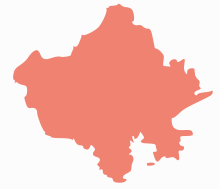Jalore
Jalor, also known as Granite City, is a city in the western Indian state of Rajasthan. It is the administrative headquarters of Jalore District.
Jalore jalor | |
|---|---|
city | |
 Jalore Location in Rajasthan, India  Jalore Jalore (India) | |
| Coordinates: 25.35°N 72.62°E | |
| Country | |
| State | Rajasthan |
| District | Jalor |
| Elevation | 178 m (584 ft) |
| Population (2011) | |
| • Total | 54,081 |
| Languages | |
| • Official | Hindi |
| Time zone | UTC+5:30 (IST) |
| PIN | 343001 |
| Telephone code | 912973 |
| Vehicle registration | RJ-16, RJ -46 |
| Nearest city | Sirohi, Barmer, Mehsana, Jodhpur |
| Website | jalore |
It has a river known as Jawai Nadi. Jalore lies to south of Sukri river, a tributary of Luni river and the river Jawai Nadi passes through it. The city is about 140 km (87 mi) south of Jodhpur and 489 km (304 mi) from the state capital Jaipur. Jalore hasn't grown that much in terms of infrastructure. The city center has many corporate offices like Axis Bank, Punjab National Bank, UCO Bank, Birla Sun Life Insurance Ltd, Shreeram Transport Finance Company among others. Dungara Ram Choudhary, of IIT-JEE 2002 AIR 1 fame, hails from this hamlet.[1]
History
In ancient times Jalore was known as Jabalipura - named after the Hindu saint Jabali. The town was also known as Suvarngiri or Songir, the Golden Mount, on which the fort stands. It was a flourishing town in the 8th century, and, according to some historical sources, in the 8th-9th centuries, one branch of the Gurjara-Pratihara ruled at Jablipur (Jalore).[2]
In the 10th century, Jalore was ruled by the Paramaras. In 1181, Kirtipala, the youngest son of Alhana, the Chahamana ruler of Nadol, captured Jalore from the Paramaras and founded the Jalore line of Chauhans. His son Samarasimha succeeded him in 1182. Samarasimha was succeeded by Udayasimha, who expanded the kingdom by recapturing Nadol and Mandor from the Turks. During Udayasimha's reign, Jalore was a tributary of the Delhi Sultanate.[3]. Udayasimha was succeeded by Chachigadeva and Samantasimha. Samantasimha was succeeded by his son Kanhadadeva.
During the reign of Kanhadadeva, Jalor was attacked and captured in 1311 by the Delhi's Turkic Sultan Alauddin Khalji. Kanhadadeva and his son Viramadeva died defending Jalore.
Jalore was the hometown of Jeevant Kunwar, mother of Maharana Pratap (1572–1597). She was the daughter of Akhey Raj Songara. Rathore rulers of Ratlam used the Jalore fort to safe-keep their treasure.
The Turkic rulers of Palanpur State of Gujarat briefly ruled Jalor in the 16th century and it became part of the Mughal Empire. It was restored to Marwar in 1704, and remained part of the kingdom until shortly after Indian Independence in 1947.
Ambliara princely state in Gujarat are the pedigree of Jalore Maharani Popadevi. Ambliara has a small princely state in Mahi Kantha Agency Present days near Bayad taluka of Aravalli District Gujarat.
There are 12 Math (Big Hindu monasteries) and 13 Takiya (Masjid).
Jalore is known as the "Cradle of the Marwari horse" - an indigenous horse breed famed for its beauty, endurance and loyalty to the horsemen who fought interminable wars on horseback.
Visitor attractions of Jalore
- Jalore Fort
- Topekhana
One of the most important structures within the town is the Topekhana or "the cannon foundry". The building is not in the best of conditions now, but its architecture indicates that this structure must have been awesome in the old days. It was built by "Ujjain King" Vikramaditya as a "Sanskrut Pathshala" for education for his public. But at the time of Muslim Emperor Alauddin Khalji converted into a Muslim monument. The structure is imposing, with a spacious forecourt and an intricate facade. The colonnade and the ceiling are tastefully carved.
- Jain Temples
- Jain temples built in the 8th century, dedicated to the first Tirthankara of Jainism, Rishabha, the 16th Tirthankara, Shantinath, the 23rd Tirthankara, Parsva and the 24th Tirthankara, Mahavira,
- Derasars of Rishabha, Munisuvrata, Acharya Rajendrasuri and Neminath
- Hindu Temple
- Sire Mandir at Jalore
- Sundha Mata
- Kailashdham at Bishangarh with huge statue of lord Shiva.
- Dhabbawali Mata Temple[4] at Khasravi
- Jain Tirth Bhandavpur, an ancient Jain centre which is now a major pilgrimage place[5]
- Mosque
- Malik Shah's mosque
References
- Balachandran, Shelly Walia, Manu. "These ten guys aced the IIT entrance exam. Here's what they're doing after graduation". Quartz India. Retrieved 11 August 2020.
- Neelima Vashishtha (1989). Sculptural traditions of Rajasthan: ca. 800-1000 A.D. Publication Scheme. p. 6.
- Srivastava, Ashok Kumar (1979). The Chahamanas of Jalore. Sahitya Sansar Prakashan. p. 14-24.
- "जानें सांचौर के इस मंदिर से जुड़ी दिलचस्प बात". Thar Post. Retrieved 18 May 2017.
- http://bhandavpur.com/
